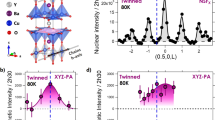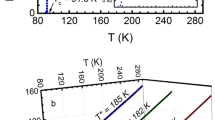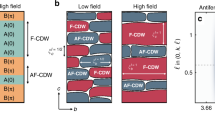Abstract
Understanding the magnetic excitations in high-temperature (high-Tc) copper-oxide superconductors is important because they may mediate the electron pairing for superconductivity1,2. By determining the wavevector (Q) and energy (ħω) dependence of the magnetic excitations, it is possible to calculate the change in the exchange energy available to the superconducting condensation energy3,4,5. For the high-Tc superconductor YBa2Cu3O6+x, the most prominent feature in the magnetic excitations is the resonance6,7,8,9,10,11,12. Suggestions that the resonance contributes a major part of the superconducting condensation4,13 have not gained acceptance because the resonance is only a small portion of the total magnetic scattering12,13,14. Here, we report an extensive mapping of magnetic excitations for YBa2Cu3O6.95 (Tc∼93 K). Absolute intensity measurements of the full spectra allow us to estimate the change in the magnetic exchange energy between the normal and superconducting states, which is about 15 times larger than the superconducting condensation energy15,16—more than enough to provide the driving force for high-Tc superconductivity in YBa2Cu3O6.95.
Similar content being viewed by others
Main
If magnetic excitations are mediating electron pairing in the high-Tc copper oxides, it is expected that the change in magnetic exchange energy will provide enough energy for superconducting condensation. The condensation energy is known experimentally from specific heat measurements for YBa2Cu3O6.95 (YBCO) to be ∼3 K per formula unit15,16 (f.u.). Within the t–J model, the change in magnetic exchange energy can be calculated from the nearest-neighbour spin correlations3,4,5 between the normal (N) and superconducting (S) states:

where J is the exchange interaction, and Si and Sj are the electron spin operators at nearest-neighbour Cu sites i and j in the CuO2 plane, respectively. Instead of estimating the magnetic resonance’s contribution to the superconducting condensation4,13, here we seek to calculate ΔEex from the entire observable magnetic excitation spectrum. In general, a complete determination of the magnetic excitation spectrum is difficult as spin fluctuations can spread over a large wavevector and energy range. YBCO has two CuO2 planes per unit cell (bilayer) and therefore the magnetic excitations have odd (acoustic) or even (optical) symmetry with respect to the neighbouring planes (Fig. 1). For optimally doped YBCO, the magnetic excitation spectrum is dominated by a resonance mode centred at 41 meV in the acoustic channel6,7, and a mapping of the acoustic and optical magnetic excitations should allow an estimation of ΔEex.
Our experiments were carried out on the ∼117g YBCO single crystal (Tc=92.5 K) used in previous work10. We specify the momentum transfer (qh,qk,ql) (in units of Å−1) as (h,k,l)=(qha/2π,qkb/2π,qlc/2π) in reciprocal lattice units (r.l.u.), where a=3.82,b=3.88 and c=11.68 Å are lattice parameters10. a, Schematic diagram for YBCO. b, The l dependence of acoustic and optical spin fluctuations for Ei=210 meV. c, Dispersion of constant energy peaks in χo′′(Q,ω). The orientation of incommensurate peaks is shown in the inset. d, Dispersion constant energy peaks in χa′′(Q,ω). The solid line shows spin-wave dispersion from undoped YBa2Cu3O6.15 (refs 21, 22). The inset shows the orientation of the incommensurate spin fluctuations below the resonance energy. e,f, Local susceptibility of 100–15 K for optical χo′′(ω) and acoustic χa′′(ω) modes in absolute units. The red circles and black squares are obtained with cuts along the (h,1−h) and (h,h) directions with an integrating width of ±0.15 r.l.u., respectively. The inset in e shows hole-doping dependence of the optical ‘resonance’ with the red circle and the green triangle from refs 24, 25. The vertical error bars in c,d and the horizontal error bars in e,f indicate the energy integration range. The vertical error bars in e and f are statistical uncertainties (1σ).
Figure 1 summarizes the key conclusions of our work. The optical and acoustic spin fluctuations can be separated by their differences in qz dependence (Fig. 1b). The total magnetic response χ′′(Q,ω) can then be written as χ′′(qx,qy,qz,ω)=χa′′(qx,qy,ω)sin2(qzd/2)+χo′′(qx,qy,ω)cos2(qzd/2), where d=3.342 Å is the spacing between the nearest-neighbour CuO2 planes along the c axis. To probe the entire magnetic spectra in optical and acoustic channels of YBCO, we used the multi-angle position-sensitive spectrometer at the ISIS Facility12,17 and chose incident beam energies of Ei=30,40,62.5,75,90,110,130,138,160,210,280,360 and 450 meV with the incident beam along the c axis. The position-sensitive detectors allow complete determination of the Q-structure of incommensurate spin fluctuations for YBCO in one experimental setting12. This avoids the complication of deconvoluting the instrumental resolution necessary for structure determination of incommensurate peaks using triple-axis spectroscopy18. The temperatures probed were T=15,100 and 290 K. The intensity difference between 15 and 100 K is almost entirely magnetic because of the small value of Q2 probed by the experiment and the small change in the Bose factor for ħω>30 meV (refs 9, 10, 19).
Figure 2a–c summarizes the temperature dependence of the 34≤ħω≤44 meV scattering at the position of optical spin fluctuations (Ei=90 meV). A clear incommensurate scattering appears at 15 K (Fig. 2a) and is replaced by a broad response at 100 K (Fig. 2b). Figure 2d–f shows the temperature dependence of the scattering around the 41 meV acoustic resonance obtained by using Ei=210 meV. At T=15 K, the scattering shows a sharp resonance centred at (1/2,1/2) (ref. 10). On warming to 100 K, the resonance disappears (Fig. 2e). Further warming to 290 K does not change the scattering significantly (Fig. 2f).
a–f, The temperature dependence of the magnetic scattering around ħω≈40 meV at optical (a)–(c), Ei=90 meV, and acoustic (d)–(f), Ei=210 meV channels. A clear commensurate magnetic scattering is seen at ∼40 meV at 15 K in d, whereas a shows incommensurate scattering. The intensity of phonons increases with increasing temperature and wavevector (b,c).
Figure 3 summarizes the optical spin fluctuations for 31≤ħω≤75 meV. For 31≤ħω≤34 meV, the scattering shows no difference between normal and superconducting states (Fig. 3a,e). As there is little normal-state magnetic scattering, there must be an optical spin gap around 34 meV. On increasing the energy transfer to ħω=39±5 meV, where the acoustic channel has a commensurate resonance, spin fluctuations in the optical channel form a broad incommensurate structure away from (1/2,1/2) (Fig. 3b). Figure 4f confirms the incommensurate nature of the scattering and shows that the (h,h) and (h,0.5) cut directions are non-equivalent. For ħω=52±5 meV, again we find incommensurate peaks, but this time the scattering is more box-like with enhanced corners (Fig. 3c,g). The orientation of the scattering is rotated 45∘ from that in Fig. 4b, similar to acoustic high-energy spin excitations in YBa2Cu3O6.6 (ref. 12). Finally, on moving the energy to ħω=66±9 meV, the temperature difference spectrum is featureless. Inspection of the unsubtracted data at 15 K reveals no observable magnetic scattering (Fig. 3h).
a–d, Images obtained with Ei=75,90,130 and 210 meV, respectively. The image at ħω=45.5±1.5 meV does not have enough statistics to determine the Q-structure. e–h, Cuts with ħω=32.5±1.5,39±5,52±5 and 66±9 meV, respectively. The upper panel of h shows a cut through the unsubtracted data of h at 15 K. The vertical error bars in e–h are statistical uncertainties (1σ).
a–e, Images obtained with Ei=90, 210, 210, 90 and 110 meV, respectively. f–j, Cuts obtained with ħω=41±5,31±4,40±5,55.5±3.5 and 64.5±4.5 meV, respectively. The upper panel of j shows a cut through the unsubtracted data of e at 15 K. The instrumental Q-resolutions are marked by white circles in a–e. The vertical error bars in f–j are statistical uncertainties (1σ).
Figure 4a–e shows the intensity difference spectra between 15 K and 100 K at various energies in the acoustic channel. For 20≤ħω≤27 meV, the temperature difference has negative intensity, possibly due to a reduction in the magnetic response on entering the superconducting state19 or large phonon population at 100 K (Fig. 4a). A cut through the image confirms no intensity gain at low temperatures (Fig. 4f). When increasing the energy to 27≤ħω≤35 meV, the difference image shows a quartet of incommensurate peaks at (1/2±δ,1/2) and (1/2,1/2±δ) with δ=0.11±0.02 reciprocal lattice units (r.l.u.). To demonstrate that the incommensurate scattering is not circular around (1/2,1/2), we made two cuts through the image. The cut along the (h,1/2) direction clearly shows two incommensurate peaks around (1/2,1/2). In contrast, a cut along the (h,1−h) direction has no incommensurate peaks. Note that a circular symmetry at ħω=35 meV has been suggested for YBCO from previous triple-axis experiments18.
Figure 4c shows the data at the resonance energy and its wavevector dependence has a gaussian lineshape centred around (1/2,1/2) (Fig. 4h). For energies above the resonance (52≤ħω≤59 meV), the scattering is incommensurate although the low counting rate does not enable an unambiguous identification of its Q-structure (Fig. 4d,i). For ħω>60 meV, the temperature difference spectra as well as unsubtracted data show no evidence of magnetic scattering around (1/2,1/2) (Fig. 4e,j).
Figure 1e and f summarize the superconductivity-induced (15–100 K) change in the local dynamic susceptibility χ′′(ω) in absolute units for optical and acoustic channels of YBCO, respectively. In the optical channel, χo′′(ω) has a peak at ħω=46 meV, similar to theoretical expectations20. The magnetic spectral weight gradually increases from above the spin-gap value of ∼30 meV (ref. 10), peaks at 46 meV, and finally diminishes for energies above ∼70 meV. The acoustic channel behaves similarly although it peaks at the expected resonance position of 40 meV (ref. 10). The magnitude of the total spectral weight in the optical channel 〈m2〉op=0.078±0.02 μB2 and in the acoustic channel is 〈m2〉ac=0.102±0.02 μB2 f.u.−1 respectively. This value is similar to that for YBa2Cu3O6.6 around the acoustic resonance energy (〈m2〉ac=0.12±0.02μB2 f.u.−1 for 24<ħω<44 meV)12. As the high-energy response in underdoped YBa2Cu3O6+x (x=0.5,0.6) takes up much more spectral weight than the resonance11,12, it is surprising that there is essentially no observed magnetic response for energies above 60 meV in YBCO (Fig. 1f). Compared with undoped YBa2Cu3O6.15 (refs 21, 22), which has a total integrated moment of ∼0.4μB2 f.u.−1 when integrated up to 120 meV, the total integrated moment in optimally doped YBCO has only about 26% of the spectral weight in the same energy range only in the acoustic channel.
Using the spin excitation spectra in Figs 3 and 4, we have calculated the changes in the magnetic excitations from the normal to the superconducting state and estimated δ〈Si·Sj〉=−0.020±0.008 f.u.−1, where 〈Si·Sj〉 is the spin–spin correlation function for nearest-neighbour copper atoms (see Supplementary Information). This estimate neglects contributions from energies below 24 meV and above 70 meV, where magnetic scattering is difficult to resolve. Also, in equation (1) the difference between the normal and superconducting states is meant to be determined at the same temperature, whereas here we had to take normal-state data at 100 K and superconducting-state data at 15 K, neglecting a possible temperature dependence of the normal-state magnetic excitations. To assess the error introduced by these neglections, we have fitted an RPA–BCS (random phase approximation–Bardeen–Cooper–Schrieffer) model calculation of the spin excitation spectrum23 to our data and calculated the missing contributions within this model. This calculation indicates that our value for ΔEex could be of the order 30% too large due to these neglections (see Supplementary Information).
Assuming an exchange coupling of J=100 meV, the change in exchange energy would be ΔEex=2J δ〈Si·Sj〉=−4.1 meV f.u.−1=−24 K per planar Cu. This value is a factor of 1.3 times larger than the 18 K per Cu estimated from the acoustic resonance alone in previous work4. Even if we consider that our estimation may be too large by 30%, the change in the exchange energy is still much larger than the  condensation energy15,16.
condensation energy15,16.
Our results reveal two important conclusions for spin excitations of optimally doped YBCO. First, the optical resonance reported earlier24,25 is actually incommensurate and this naturally explains the large Q widths previously reported. Second, our determination of the dynamical susceptibility in absolute units enables an estimation of the change of the magnetic excitation energy available to the superconducting condensation energy 4,14,26. We find that the magnetic exchange energy is about 15 times larger than that of the superconducting condensation energy, thus indicating that magnetism can be the driving force for electron pairing and superconductivity.
References
Scalapino, D. J. The case for d x 2 − y 2 pairing in the cuprate superconductors. Phys. Rep. 250, 330–365 (1995).
Chubukov, A., Pines, D. & Schmalian, J. in The Physics of Superconductors, Vol I, Conventional and High-T c Superconductors (eds Bennemann, K. H. & Ketterson, J. B.) 495–590 (Springer, Berlin, 2003).
Scalapino, D. J. & White, S. R. Superconducting condensation energy and an antiferromagnetic exchange-based pairing mechanism. Phys. Rev. B 58, 8222–8224 (1998).
Demler, E. & Zhang, S.-C. Quantitative test of a microscopic mechanism of high-temperature superconductivity. Nature 396, 733–735 (1998).
Maier, Th. A. On the nature of pairing in the two-dimensional t–J model. Physica B 359–361, 512–514 (2005).
Rossat-Mignod, J. et al. Neutron scattering study of the YBa2Cu3O6+x system. Physica C 185, 86–92 (1991).
Mook, H. A. et al. Polarized neutron determination of the magnetic excitations in YBa2Cu3O7 . Phys. Rev. Lett. 70, 3490–3493 (1993).
Mook, H. A. et al. Spin fluctuations in YBa2Cu3O6.6 . Nature 395, 580–582 (1998).
Fong, H. F. et al. Spin susceptibility in underdoped YBa2Cu3O6+x . Phys. Rev. B 61, 14773–14786 (2000).
Dai, P., Mook, H. A., Hunt, R. D. & Doğan, F. Evolution of the resonance and incommensurate spin fluctuations in superconducting YBa2Cu3O6+x . Phys. Rev. B 63, 054525 (2001).
Stock, C. et al. From incommensurate to dispersive spin-fluctuations: The high-energy inelastic spectrum in superconducting YBa2Cu3O6.5 . Phys. Rev. B 71, 024522 (2005).
Hayden, S. M., Mook, H. A., Dai, P., Perring, T. G. & Doğan, F. The structure of the high-energy spin excitations in a high-transition-temperature superconductor. Nature 429, 531–534 (2004).
Dai, P. et al. The magnetic excitation spectrum and thermodynamics of high-T c superconductors. Science 284, 1344–1347 (1999).
Kee, H-Y., Kivelson, S. A. & Aeppli, G. Spin-1 neutron resonance peak cannot account for electronic anomalies in the cuprate superconductors. Phys. Rev. Lett. 88, 257002 (2002).
Loram, J. W., Mirza, K. A., Cooper, J. R. & Tallon, J. L. Specific heat evidence on the normal state pseudogap. J. Phys. Chem. Solids 59, 2091–2094 (1998).
Lortz, R. et al. Evolution of the specific-heat anomaly of the high-temperature superconductor in YBa2Cu3O7 under the influence of doping through application of pressure up to 10 GPa. J. Phys. Condens. Matter 17, 4135–4145 (2005).
Woo, H. et al. Mapping spin-wave dispersions in stripe-ordered La2xSrxNiO4 (x=0.275,0.333). Phys. Rev. B 72, 064437 (2005).
Reznik, D. et al. Dispersion of magnetic excitations in optimally doped superconducting YBa2Cu3O6.95 . Phys. Rev. Lett. 93, 207003 (2004).
Regnault, L. P. et al. Spin dynamics in the high-T c superconducting system YBa2Cu3O6+x . Physica B 213/214, 48–53 (1995).
Chen, W. Q. & Weng, Z. Y. Spin dynamics in a doped-Mott-insulator superconductor. Phys. Rev. B 71, 134516 (2005).
Hayden, S. M. et al. High-frequency spin waves in YBa2Cu3O6.15 . Phys. Rev. B 54, R6905–R6908 (1996).
Reznik, D. et al. Direct observation of optical magnons in YBa2Cu3O6.2 . Phys. Rev. B 53, R14741–R14744 (1996).
Dahm, T. et al. Nodal quasiparticle lifetimes in cuprate superconductors. Phys. Rev. B 72, 214512 (2005).
Pailhes, S. et al. Resonant magnetic excitations at high energy in superconducting YBa2Cu3O6.85 . Phys. Rev. Lett. 93, 167001 (2004).
Pailhes, S. et al. Two resonant magnetic modes in an overdoped high T c superconductor. Phys. Rev. Lett. 91, 237002 (2003).
Chakravarty, S. & Kee, H-Y. Measuring condensate fraction in superconductors. Phys. Rev. B 61, 14821–14824 (2000).
Acknowledgements
We thank E. Dagotto, Z. Y. Wen and F. C. Zhang for helpful discussions. This work is supported by the US DOE Office of Science, Division of Materials Science, Basic Energy Sciences under contract No. DE-FG02-05ER46202 (H.W. and P.D.). Oak Ridge National Laboratory is supported by the US DOE under contract No. DE-AC05-00OR22725 with UT/Battelle LLC. S.M.H. is supported by the UK EPSRC. D.J.S. would like to acknowledge the Center for Nanophase Material Science at Oak Ridge National Laboratory for their support.
Author information
Authors and Affiliations
Corresponding authors
Ethics declarations
Competing interests
The authors declare no competing financial interests.
Supplementary information
Rights and permissions
About this article
Cite this article
Woo, H., Dai, P., Hayden, S. et al. Magnetic energy change available to superconducting condensation in optimally doped YBa2Cu3O6.95. Nature Phys 2, 600–604 (2006). https://doi.org/10.1038/nphys394
Received:
Accepted:
Published:
Issue Date:
DOI: https://doi.org/10.1038/nphys394
This article is cited by
-
Coupled electronic and magnetic excitations in the cuprates and their role in the superconducting transition
Communications Physics (2022)
-
High-energy magnetic excitations from heavy quasiparticles in CeCu2Si2
npj Quantum Materials (2021)
-
Electrically tunable organic–inorganic hybrid polaritons with monolayer WS2
Nature Communications (2017)
-
Close relationship between superconductivity and the bosonic mode in Ba0.6K0.4Fe2As2 and Na(Fe0.975Co0.025)As
Nature Physics (2013)
-
Doping dependence of spin excitations and its correlations with high-temperature superconductivity in iron pnictides
Nature Communications (2013)







